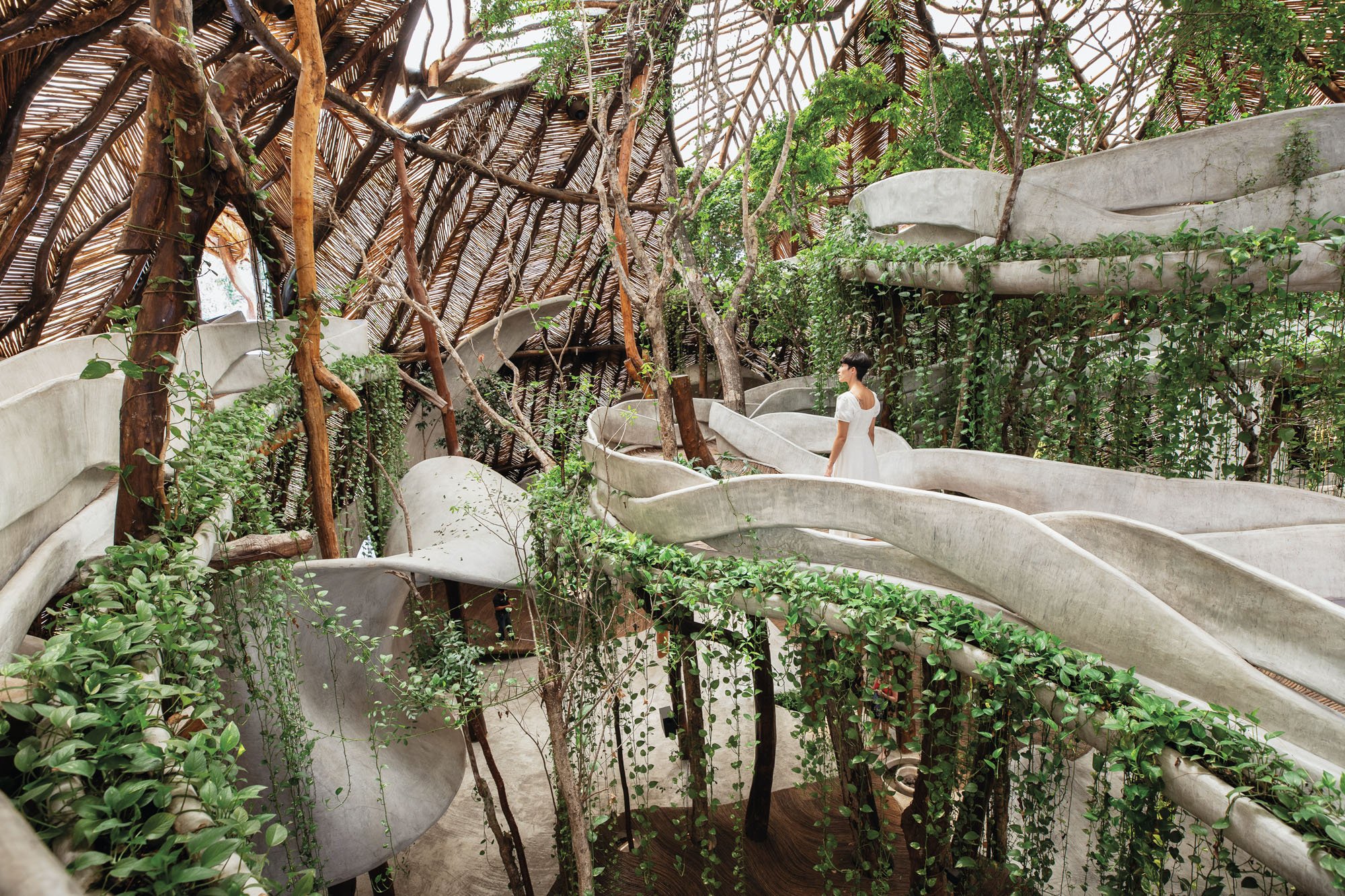Table Of Content
An image of One Central Park in Australia is one of the most famous examples of sustainable architecture you will encounter. This mixed use, high-rise building is famous for its striking hanging gardens and cantilevered heliostat – a device that reflects sunlight onto its retail atrium, public terrace and surrounding areas. The Ha Long Villa is situated in the town of Ha Long, 150km away from the city of Hanoi. Constructed from exposed concrete, the villa is full of layers of greenery, so much so that the intention of its design philosophy is to make its occupants feel as though they’re living in a forest. 1 Hotels is a luxury hotel brand that have been making waves for their sustainable and biophilic hotel designs. They describe their mission as ‘getting people to reconnect with nature through art and design’ and have locations across the world, from the USA, the UK and China to, eventually, new hotels in Greece, France and Australia.
Leaflike – flying the biophilic flag in hotel design - Hotel Designs
Leaflike – flying the biophilic flag in hotel design.
Posted: Thu, 08 Jun 2023 07:00:00 GMT [source]
Why is Biophilic Design Important: The Benefits

As the International Style took root, it spread glass buildings everywhere; unfortunately, the buildings, and particularly the interiors of commercial buildings, increasingly disconnected people from nature. Biophilic designs are achieved by bringing the forms and patterns of nature into buildings. These natural features can either directly use light, air, water, or plants or nature-inspired images, colors, simulations, naturalistic shapes, etc. “Touching and smelling plants can reduce physiological and psychological stress and elevate mood,” says Carr, who looks for species known to optimize air quality in our indoor spaces, like the Mass Cane, a popular variety of Dracaenas with vibrant foliage.
How Biophilic Design Can Improve Your Well-Being
When people feel good and happy with where they are, are become more excited to do the work. If we connect and look deeper into nature, it could help us in our own lives and make them better. There are some stunning examples of biomimetic architecture that use nature as a model. On the other hand, man-made ones are finite and will therefore run out someday in the near future. But they should also not be too processed and not have any toxic chemicals in them.
Principles of Biophilic Design
The focal points within the park (trees, buildings, lake and meadows) give the space a degree of legibility, but obscured views entice occupants to explore the space further, in order to understand it, which cannot be achieved in a single visit. Mystery conditions have their place among indoor and outdoor plazas, corridors, pathways, parks, and other transitory spaces. The sense of mystery can be diluted over time and with routine exposure; however, strategies that include revolving content or information, such as peek-a-boo windows into common areas where activity is constantly changing, will be most effective in spaces routinely occupied by the same group of people. Sitting with one's back against the trunk of a big shade tree is a classic refuge space, as is high backed booth seating in a restaurant, a reading nook in a library or school, a covered bus stop, or a wraparound porch.
Staff break areas should be located in ways that provide easy and rapid access back to patients and also to outdoor spaces which appears to be one of the most critical applications of biophilic design for staff well-being. This article is part of an ArchDaily series that explores features of interior architecture, from our own database of projects. Every month, we will highlight how architects and designers are utilizing new elements, new characteristics and new signatures in interior spaces around the world. Mystery in design engenders a sense of anticipation that encourages one to travel further into the space to explore and is often achieved through partially obscured views (Browning et al. 2014).

Physiological responses triggered by connections with nature include relaxation of muscles, as well as lowering of diastolic blood pressure and stress hormone (i.e., cortisol) levels in the blood stream (e.g., 25. Park et al., 2009 ). Short term stress that increases heart rate and stress hormone levels, such as from encountering an unknown but complex and information-rich space, or looking over a banister to 8 stories below, is suggested to be beneficial to regulating physiological health (26. Kandel et al., 2013 ). Biophilic design can reduce stress, improve cognitive function and creativity, improve our well-being and expedite healing; as the world population continues to urbanize, these qualities are ever more important. Biophilic design can reduce stress, enhance creativity and clarity of thought, improve our well-being and expedite healing; as the world population continues to urbanize, these qualities are ever more important. Theorists, research scientists, and design practitioners have been working for decades to define aspects of nature that most impact our satisfaction with the built environment.
Then imagine the peace of bringing a hot beverage outside in the morning or falling asleep to crickets. This increasing separation from nature is reflected in much of our modern agriculture, manufacturing, education, healthcare, urban development, and architectural design. Then there’s the world’s greenest apartment complex, the Bosco Verticale in Milan, Italy. It’s comprised of two forested skyscrapers with 2,000 tree species on their facades. Besides being biophilic, that project aims to promote plant and animal biodiversity, along with other environmental benefits.
As more realize the benefits and importance of having nature in our lives, creating biophilic design will become the primary goal. They don’t even need to be of direct elements of nature like plants or landscapes. Even having abstract shapes and patterns with the right colors can make us think of nature. It will allow water to follow its natural cycle and won’t obstruct the natural flow of nutrients either. Other ways to develop sponge cities include adding natural flood barriers, forests, and parks.
Khoo Teck Puat Hospital – Yishun, Singapore
“To see the plants running in a horizontal orientation is something that brings repose, relaxation and tranquility rather than vertical movements that start to feel almost jail-like,” she explained. Technology also makes it easy and inexpensive to bring nature sounds into your home. It’s as simple as asking your smart speaker to play forest sounds or ocean sounds or just about any natural auditory experience you can think of. She likes calming hues, especially blues or colors with a blue base, with accents of verdant green, “for example an accent table in Farrow and Ball’s Folly Green, to support balance and harmony.” Find local painters to help with the project. While not as effective as the real thing, simulated views ofnature have some benefit.
This includes using natural materials, incorporating greenery, an abundance of natural light, and making room for natural ventilation, to name a few. The successful application of biophilic design principals stimulates a wide spectrum of physical, mental and behavioral benefits. Physical benefits include improved fitness, lower blood pressure, and fewer illness symptoms.
Research shows that biophilic design is more than an aesthetic choice—it can impact productivity and well-being. A study by global flooring company Interface found that people spent 11% more time in biophilic-inspired hotel lobbies as compared to less nature-forward lobbies. Green building consulting firm Paladino & Company also estimated a 5% increase in student test scores and a 15% reduction in absenteeism when schools in Washington State switched to a biophilic design approach. City-wide infrastructure can be designed biophilically, too, like when a city prioritizes green spaces, foot traffic, or community gardens. One of the earliest examples of intentional biophilic design was the Hanging Gardens of Babylon, rooftop gardens by the royal palace in ancient Babylon.

No comments:
Post a Comment